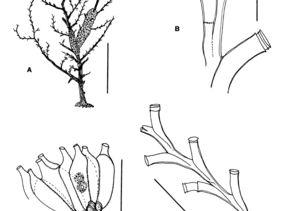You are here
Taxon
Acryptolaria conferta (Allman, 1877)
Nomenclature
-
Family: LafoeidaeGenus: Acryptolaria
-
Synonyms: 2
SUMMARY
Simple and branched colonies connected by hydrorhiza reptant on gorgonian. Larger branched colonies flabellate, up to 50 mm high and 35 mm wide, stems to 1 mm wide at base; colonies arising from a thick plug of stolons, simple stems from single stolons.
Stem and branches of flabellate colonies heavily fascicled, with roughly longitudinal polysiphonic tubes running upwards from stem and along branches; ultimate parts of branches (hydrocladia) monosiphonic. Branching irregular, of up to 3 orders, branches given off behind a hydrotheca, best seen in distal parts of colony. Monosiphonic branches weakly geniculate, given off from behind a hydrotheca.
Hydrothecae biseriate, alternate, scarcely overlapping, often frontally directed; on monosiphonic branches biseriate arrangement of hydrothecae sometimes replaced by incipient whorls of three around hydrocladium; on fascicled parts of stem and branches hydrothecae often not strictly alternate, immersed in polysiphonic tubes with only distal part or margin visible. Hydrocladial hydrothecae long, tubular, bending outwards at an angle of 40–50° to hydrocladial axis; adcauline wall convex, often a slight change in convexity where wall becomes free; free part about same length as adnate part, hydrotheca narrowing proximally along adnate wall, sometimes fading into a ragged septum. Abcauline wall curving smoothly into hydrocladium, usually a transverse ring of desmocytes just above narrowest part of hydrotheca, marking site of attachment of hydranth. Margin circular, rim transverse to hydrothecal axis, slightly but distinctly everted; up to seven marginal replications common. Perisarc of stem and branches firm, thinning a little on hydrotheca.
Hydranths too poorly preserved for description.
Coppinia situated about halfway up stem, spreading for 10 mm along a branch and 5 mm along adjoining stem; coppinia cylindrical, diameter 2 mm, texture rather spongy.
Gonothecae radially arranged within coppinia around polysiphonic tubes of stem and branch; flask-shaped, sides more or less straight, conjoined to neighbours, expanding from narrow base to a rounded shoulder surmounted by an erect tubular neck narrowing into a circular non-everted terminal orifice. No protective tubules present. Small spherical planulae visible in some gonothecae.
Colour: Colony translucent honey-gold; hydranths probably of same colour; gonophores creamy pink.

